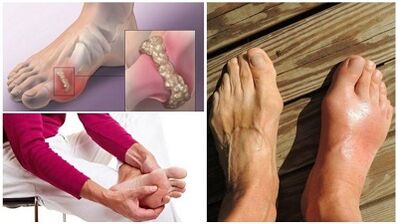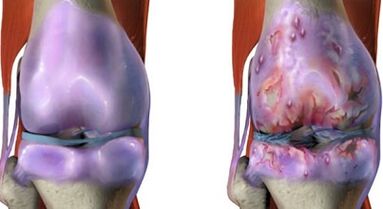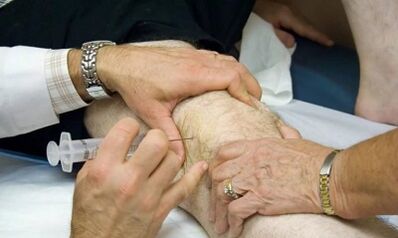People who are first encountered with joint diseases often ask: arthritis and arthrosis - what is the difference.These pathologies have similar names and symptoms, so they are often confused.With suicide, this confusion can cause negative effects, as what helps with arthritis with arthritis can harm.
Both of these diseases are serious, leading to damage, so the treatment of joint diseases should be performed by a specialist.
What is the nature of these diseases?
The difference between arthrosis and arthritis is already clear from their names.The suffix "IT" in the name of the disease shows the inflammatory nature of the disease and "OZ" - the presence of pathological changes in the tissues.
Accordingly, arthritis is an inflammation of the joint tissue, which can be caused by various causes.And arthrosis is a degenerative changes in the articular cartilage, developing after injury or the action of age -related factors.We will find out more arthritis and arthrosis.
Arthrosis - What is it?

The articulated surfaces of the bones are covered with smooth cartilage tissue and constantly greased with synovial fluid for light sliding.Arthrosis is characterized by pathological processes, which leads to the fact that the surface of the cartilage loses smoothness, is ulcer and complex.
Therefore, during the friction of mating cartilage surfaces, they are scratched by each other, as a result of this degenerative processes deteriorate until the cartilage is completely destroyed.The growth appears at the ends of the bones - osteophytes that overcome the mobility of the joint.
With the timely detection of arthrosis, the process of cartilage destruction can be delayed for decades, using modern methods of treatment and prevention.But as a rule, in the end, arthrosis leads to complete destruction of cartilage and immobilization of the affected joint.
The only way to return to it lost functionality is to replace the joint with artificial endoprosthesis.
Arthritis - What is it?
Arthritis is an inflammation of the joints.It is known that the inflammatory process is nothing more than the fight against immune blood cells (leukocytes) with external formations in the body.Most often, immune cells are suspended against an infection that has fallen.
In the place of this fight, inflammation occurs, characterized by redness, fever, pain and swelling.The leukocytes that died during body protection are nothing more than pus are often formed in the process of inflammation.
Arthritis can be of a different character.Sometimes it happens when the infection enters the joint cavity.Such types of arthritis are good for treating antibiotics and often pass without consequences.

Other species of this disease are worse for treatment and usually lead to damage.In particular, it is a rheumatoid arthritis - an autoimmune disease in which the immune cells lose their guidelines and begin to fight the tissues of their own body.
Gotric arthritis is found in the elderly due to impaired metabolism and deposits in the joints of the salts.
Psoriatic arthritis, which is found in approximately 10% of patients with psoriasis, as well as many other types of this dangerous disease.
Is there a connection between these diseases?
By disassembling how arthrosis differs from arthrosis, it cannot be mentioned that these diseases are often accompanied.For example, in rheumatoid arthritis, joint tissues are subjected to degenerative changes characteristic of arthrosis.Over time, the joints affected by rheumatoid arthritis deform and lose their functions as in arthrosis.
Similar can be said of gout arthritis.Acute salts crystals that are deposited in the articular cartilage, on the one hand, cause their inflammation, and on the other, they scratch the surfaces of the cartilage, which causes its abrasion and gradual degeneration characteristic of arthrosis.
As you can see, the chronic forms of arthritis adversely affect the condition of the old cartilage and over time lead to the progression of the processes characteristic of arthrosis - deformity and loss of joint functions.
This rule works otherwise.The course of arthrosis is rarely complete without concomitant arthritis.When the surfaces of the articular cartilage, destroying due to degenerative processes, rub against each other, microtraumas appear on them, pieces of cartilage can be abandoned.This causes inflammatory processes and we already know that inflammation in the joints is arthritis.
In this way, arthrosis occurs in periodic exacerbations, which are often accompanied by attached arthritis.
Due to the fact that these two diseases are so interconnected, it is sometimes difficult to understand: arthritis and arthrosis-what is the difference.To decide, you need to look at the root cause of the disease, for what the pathological process is launched.If the impetus of the disease has become degenerative changes in cartilage, then it is arthrosis and if the cause of inflammation caused by infections, problems with hormonal background, immunity or metabolism, it is arthritis.
What are the causes of these pathologies?

Arthrosis is a degenerative dystrophic change in cartilage that develops for reasons:
- Insufficient tissue feeding;
- Traumatic nature.
Lack of nutrition occurs as a rule due to changes in age in the body.Therefore, arthrosis often occurs in people over 50-60 years of age.At this age, tissue regeneration slows down, there are disorders in the metabolic processes, which in many causes joint problems.
Traumatic arthrosis can develop at a younger age.Its reason is congenital, as well as acquired defects on the old cartilage, which injure the surface of the mating of the cartilage, which provokes their more destruction.
Traumatic arthrosis is projected to be:
- Congenital defects of the articular cartilage;
- Injuries obtained;
- Joint surgery;
- Large excess of body weight.
Arthritis, unlike arthrosis, with the exception of gout, is more common in young people.His reasons are:
- Genetic predisposition to autoimmune and systemic diseases;
- Infections;
- Hormonal disorders.
What is similarity and difference in symptoms?
Arthrosis is characterized by a gradual, slow increase in symptoms.The initial stage of the disease can last for years without showing.One can be felt in the joints, occasionally, a cargo pain above the usual.
Most often, the doctor is addressed when the disease has already reached stage II.Characteristic symptoms of arthrosis:
- Joint pain when loading is resting at rest;
- Clicks when moving the problem joint;
- Morning stiffness when after waking up for normal joint work it is necessary to "develop";
- Most often the joints of the brushes, the stopping, the spine, the knee and the hip joint are susceptible to arthrosis;rarer - shoulder and ankle;
- The onset of rest pain, night pain shows attached arthritis-inflammation due to constant cartilage micro-tract;
- In the short stages, a progressive reduction in the movement amplitude is joined, until complete immobilization of the joint or, conversely, the appearance of "decay", unnatural mobility.

Not an example of arthrosis, arthritis begins with pronounced symptoms characteristic of inflammatory processes:
- Severe pain in the joint, does not even end at rest, feels pulsation, trembling;
- Night pain that does not allow to fall asleep;
- Redness, swelling in the area of lesion;
- High temperature at the site of inflammation, frequent fever in the whole body;
- The small joints are more susceptible to arthritis - wrists, fingers, sometimes ankle, knees;
- Several joints (polyarthritis) are often influenced at the same time;
- Often arthritis becomes a complication of diseases caused by bacterial and viral infections.
The other symptoms of arthritis vary depending on its species, of which there are many.Many types of arthritis are serious diseases that affect other bodily systems in addition to the joints.
Diagnostics
For the doctor, the difference between arthritis and arthrosis is obvious from the clinical picture.Often, in order to diagnose arthrosis and to establish your stage, it is sufficient to do the X -D, the problem joint in two projections.The picture will show the value of the articular gap, the presence or absence of bone growths - osteophytes, the degree of bone deformity.

The diagnosis of arthritis requires more studies, as successful treatment needs to be identified by a type of pathology - whether a systemic disease is a system, whether inflammation is caused by infection or exacerbation of arthrosis.
To determine an accurate diagnosis, such modern diagnostic methods such as ultrasound, CT, MRI, arthroscopy, joint puncture can be used to examine the synovial fluid.Of great importance in the diagnosis of arthritis is a blood test for roar.
Similarity and difference in therapy
The treatment of arthritis and arthrosis has more differences from the similarities.Almost the only thing that unites them is the use of non -steroidal anti -inflammatory drugs (NSAIDs) to eliminate pain and inflammation.Depending on the diagnosis and condition of the patient, these drugs can be used for topical administration, orally or in the form of injections, including the joint cavity.
With the ineffectiveness of the treatment of NSAIDs, hormonal drugs are used - corticosteroids that have strong side effects so that they are prescribed only in extreme cases.
Otherwise, arthritis and arthrosis therapy varies.Each type of arthritis has its own treatment regimen that takes into account the nature of the disease.In therapy of each type, in addition to NSAIDs, antibiotics, hormonal, immunobiological drugs and many other specific drugs, including physiotherapy.
The main purpose of treating arthritis is to relieve inflammation, therapy of concomitant diseases and to provide a long period of remission.In cases of severe joint damage, surgery is indicated.
In the treatment of arthrosis, the main task is to slow down the pathological processes of the destruction of the articular cartilage.For this, chondroprotectors are actively used - medicines that contribute to the regeneration of joint cartilage, as well as to vitamins and minerals.At the remission stage, patients are shown physiotherapy procedures, physiotherapy exercises.

Of great importance is attached to prevention measures:
- Normalization of weight;
- Proper full meal;
- Rejection of bad habits;
- Refusal to overload inflamed joints;
- Feasible motor activity.
After severe stages of arthrosis, due to the immobility of the joint or vice versa, the non-surgical mobility may be lost by the functionality of the limb.In such cases, the patient will help to return to a complete life surgery to replace the damaged joint with an endoprosthesis.
Unfortunately, there are no therapeutic agents to restore the joints, destroyed by arthrosis and arthritis.It is only possible to stretch this pathological process, as far as possible in time and after the failure of the joint, resorts to surgery.It is therefore very important not to delay the visit to the doctor, noting the first signs of these diseases.
As you can see, the difference between arthritis and arthrosis determines the differences in their treatment.Arthritis therapy is focused on eliminating the inflammatory process and the treatment of concomitant diseases and in the treatment of arthrosis relief of pain and preventing more destruction of the joints are the first in the treatment of arthrosis.
In this context, it is clear how to connect to the warming of the joints in these diseases.Heating the problem area helps to activate blood circulation in nearby tissues.
With degenerative-dystrophic processes in cartilage tissue, blood flow improves oxygen joint and nutrients, accelerates metabolic processes.This helps to improve the regeneration of joint tissue.So, with arthrosis, it is useful to heat the joints.
Heating pads and warming arthritis compresses have a completely different effect.In the area of the inflammatory process, the temperature is already rising.Heating only exacerbates the inflammatory process and promotes the spread of infection outside the joint.Therefore, with arthritis, heating of inflamed joints with heating pads, compresses and baths is strictly forbidden.
Conclusion
Many people are interested in: what is worse than arthritis or arthrosis.This question may seem strange because it is impossible to choose an easier illness.Both diseases are associated with severe pain, restrictions on motor activity.Arthrosis and many types of arthritis lead to damage.
But if only the joints are affected by arthrosis, for example, for example, with rheumatoid arthritis, not only joints suffer, but in practice all systems of body cardiovascular, nervous, respiratory, kidneys, skin, hematopoiesis, vision organs.
In any of these diseases, it is important to recognize them in the initial stages and to start treatment as soon as possible to slow down the progression of these pathologies, while the damage caused by the joints is not too great.



































